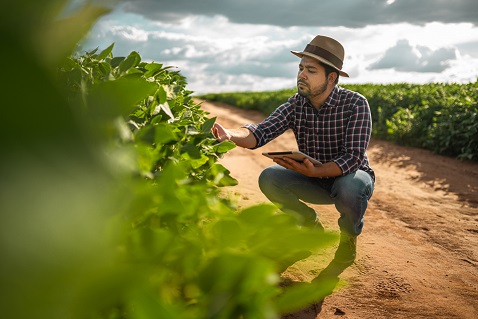 Finding practical solutions to balance food production and environmental conservation is a grand challenge the world faces today. Extensive soybean expansion in South America, at the expense of natural vegetation, pasture and other cropland, is at the forefront of this challenge. We propose to integrate satellite observations, field measurements, economic models and an agricultural ecosystem model to quantify historical patterns of soybean expansion across South America, analyze the underlying socioeconomic drivers and project future trends. We will use Landsat, MODIS and Sentinel 2 data to characterize soybean cover and map soybean expansion from 1985 to present with continentally distributed ground data for training and validation. We will design and implement a stratified random sample for field data collection and soybean area estimation, which will be subsequently used to constrain the satellite-based soybean cover maps.
Finding practical solutions to balance food production and environmental conservation is a grand challenge the world faces today. Extensive soybean expansion in South America, at the expense of natural vegetation, pasture and other cropland, is at the forefront of this challenge. We propose to integrate satellite observations, field measurements, economic models and an agricultural ecosystem model to quantify historical patterns of soybean expansion across South America, analyze the underlying socioeconomic drivers and project future trends. We will use Landsat, MODIS and Sentinel 2 data to characterize soybean cover and map soybean expansion from 1985 to present with continentally distributed ground data for training and validation. We will design and implement a stratified random sample for field data collection and soybean area estimation, which will be subsequently used to constrain the satellite-based soybean cover maps.
To understand individual landowners’ land-use decision, we will develop a spatially explicit econometric Land-Use Change (eLUC) model and use the satellite-derived soybean expansion map and other remote sensing-based land-use data to empirically calibrate the model. We will extrapolate the resulting mechanistic understanding to project future change. In addition to the microeconomic factors captured by eLUC, projection of future trajectories must also factor in changes in macroeconomic conditions, such as international trade. This requires establishing tele-connections between downstream soybean consumption and upstream soybean production. We will extend the Multi-Regional Input-Output (MRIO) analysis with soybean land footprint accounting to track the land resources embodied in the international soybean supply chain. This land-use extended MRIO analysis can effectively translate the projected soybean consumption in one country (e.g. China) to demand for land resources in the production country (e.g. Brazil), which will be subsequently used by eLUC for spatial allocation.
Projecting future trajectories must also take into account climate change and agrotechnological change, which can affect cropland suitability and yield potential, and consequently alter the costs and benefits of land-use conversion. We will assess these biophysical and technological impacts using the Global Agro-Ecological Zone (GAEZ) model. Thus, the eLUC model, MRIO analysis and the GAEZ model are synthesized in a coherent modeling framework for future scenario analysis. By integrating these different observations and models, the main goal of our proposal is to improve our scientific understanding of land-cover and land-use change in South America. The proposed 30 m resolution annual long-term soybean expansion map will serve as an important baseline for monitoring and verification of the effectiveness of deforestation-free supply chain initiatives. The spatially explicit projections of future soybean expansion will provide critical scientific insights to support various stakeholders, including individual farmers, private companies, governments and non-governmental organizations.

